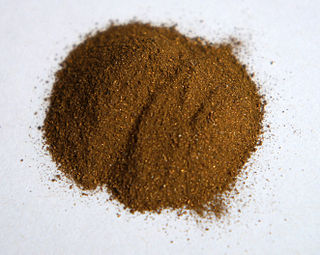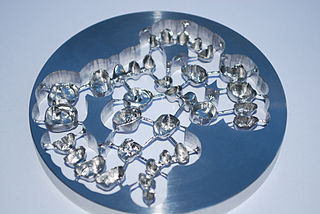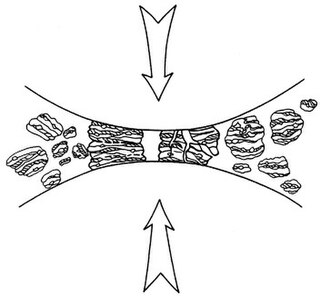
In chemistry, a carbide is a compound composed of carbon and a less electronegative element. Carbides can be generally classified by the chemical bonds type as follows: (i) salt-like, (ii) covalent compounds, (iii) interstitial compounds, and (iv) "intermediate" transition metal carbides. Examples include calcium carbide (CaC2), silicon carbide (SiC), tungsten carbide (WC; often called, simply, carbide when referring to machine tooling), and cementite (Fe3C), each used in key industrial applications. The naming of ionic carbides is not systematic.

In metallurgy, stainless steel, also known as inox steel or inox from French inoxydable (inoxidizable), is a steel alloy, with highest percentage contents of iron, chromium, and nickel, with a minimum of 10.5% chromium content by mass and a maximum of 1.2% carbon by mass.

Group 6, numbered by IUPAC style, is a group of elements in the periodic table. Its members are chromium (Cr), molybdenum (Mo), tungsten (W), and seaborgium (Sg). These are all transition metals and chromium, molybdenum and tungsten are refractory metals. The period 8 elements of group 6 are likely to be either unpenthexium (Uph) or unpentoctium (Upo). This may not be possible; drip instability may imply that the periodic table ends around unbihexium. Neither unpenthexium nor unpentoctium have been synthesized, and it is unlikely that this will happen in the near future.

Brazing is a metal-joining process in which two or more metal items are joined together by melting and flowing a filler metal into the joint, the filler metal having a lower melting point than the adjoining metal.

Chromite is a mineral and can be described as an iron chromium oxide, with a chemical formula of FeCr2O4. It is an oxide mineral belonging to the spinel group. The element magnesium can substitute for iron in variable amounts as it forms a solid solution with magnesiochromite (MgCr2O4). A substitution of the element aluminium can also occur, leading to hercynite (FeAl2O4). Chromite today is mined particularly to make stainless steel through the production of ferrochrome (FeCr), which is an iron-chromium alloy.
Plating is a surface covering in which a metal is deposited on a conductive surface. Plating has been done for hundreds of years; it is also critical for modern technology. Plating is used to decorate objects, for corrosion inhibition, to improve solderability, to harden, to improve wearability, to reduce friction, to improve paint adhesion, to alter conductivity, to improve IR reflectivity, for radiation shielding, and for other purposes. Jewelry typically uses plating to give a silver or gold finish.

A heating element converts electrical energy into heat through the process of Joule heating. Electric current passing through the element encounters resistance, resulting in heating of the element. Unlike the Peltier effect, this process is independent of the direction of current flow.

Titanium carbide, TiC, is an extremely hard refractory ceramic material, similar to tungsten carbide. It has the appearance of black powder with the sodium chloride crystal structure. As found in nature its crystals range in size from 0.1 to 0.3mm.

Inconel is a family of austenitic nickel-chromium-based superalloys.

Titanium nitride (TiN) is an extremely hard ceramic material, often used as a coating on titanium alloys, steel, carbide, and aluminium components to improve the substrate's surface properties.

A superalloy, or high-performance alloy, is an alloy that exhibits several key characteristics: excellent mechanical strength, resistance to thermal creep deformation, good surface stability, and resistance to corrosion or oxidation. The crystal structure is typically face-centered cubic austenitic. Examples of such alloys are Hastelloy, Inconel, Waspaloy, Rene alloys, Incoloy, MP98T, TMS alloys, and CMSX single crystal alloys.

Intergranular corrosion (IGC), also known as intergranular attack (IGA), is a form of corrosion where the boundaries of crystallites of the material are more susceptible to corrosion than their insides.
Electroless nickel plating (EN) is an auto-catalytic reaction that deposits an even layer of nickel-phosphorus or nickel-boron alloy on the surface of a solid material, or substrate, like metal or plastic. The process involves dipping the substrate in a bath of plating solution, where a reducing agent, like hydrated sodium hypophosphite (NaPO2H2 · H2O), reacts with the material's ions to deposit the nickel alloy. The metallurgical properties of the alloy depend on the percentage of phosphorus, which can range from 2–5% (low phosphorus) to 11–14% (high phosphorus). Unlike electroplating, it is not necessary to pass an electric current through the plating solution to form a deposit. Electroless plating prevents corrosion and wear, and can be used to manufacture composite coatings by suspending powder in the bath. EN plating creates an even layer regardless of the geometry of the surface – in contrast to electroplating which suffers from flux-density issues as an electromagnetic field will vary due to the surface profile and result in uneven depositions. Depending on the catalyst, EN plating can be applied to non-conductive surfaces.

Alloy steel is steel that is alloyed with a variety of elements in total amounts between 1.0% and 50% by weight to improve its mechanical properties. Alloy steels are broken down into two groups: low alloy steels and high alloy steels. The difference between the two is somewhat arbitrary: Smith and Hashemi define the difference at 4.0%, while Degarmo, et al., define it at 8.0%. Most commonly, the phrase "alloy steel" refers to low-alloy steels.

Cobalt-chrome or cobalt-chromium (CoCr) is a metal alloy of cobalt and chromium. Cobalt-chrome has a very high specific strength and is commonly used in gas turbines, dental implants, and orthopedic implants.




















